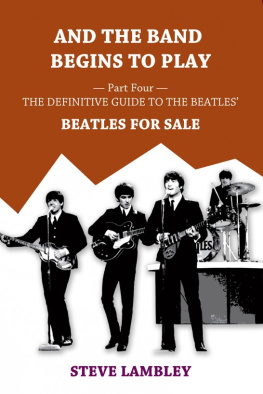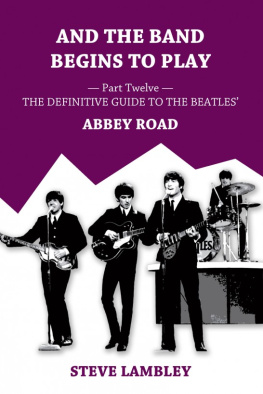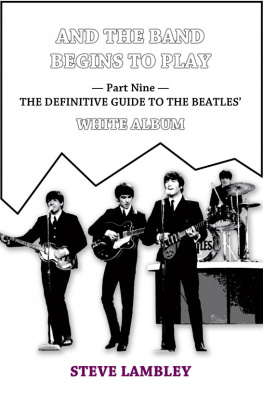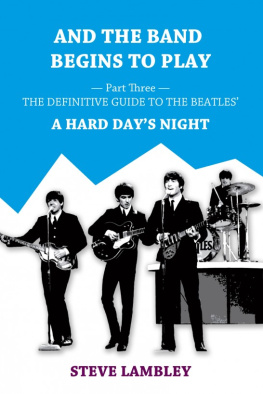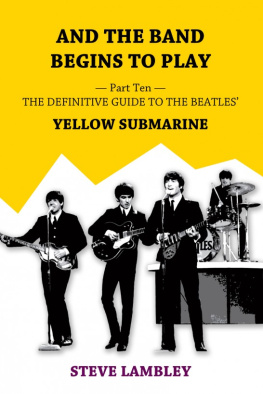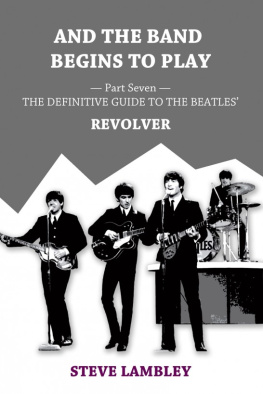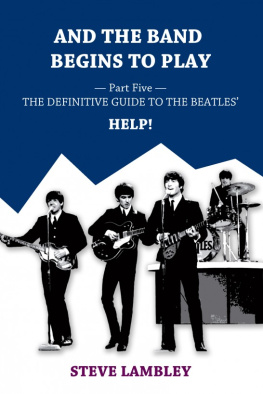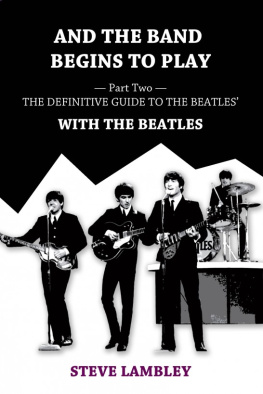AND THE BANDBEGINS TO PLAY
Part One The Definitive Guide to the Beatles PLEASE PLEASEME
by
SteveLambley
Published bySLIDE Books
Version 2.0
Steve Lambley2014
All song lyricsremain the copyright of their respective owners, and are quoted forthe purposes of scholarship, under fair dealing and fair usagelaws. No infringement is intended.
No part of thisbook may be reproduced in any form without written permission fromthe copyright holder.
SmashwordsEdition, Licence Notes
This ebook islicensed for your personal enjoyment only. This ebook may not bere-sold or given away to other people. If you would like to sharethis book with another person, please purchase an additional copyfor each recipient. If youre reading this book and did notpurchase it, or it was not purchased for your use only, then pleasereturn to Smashwords.com and purchase your own copy. Thank you forrespecting the hard work of this author.
Table of Contents
Recording and MixingDetails
Discography
Bibliography
Copyrights
Single release
Parlophone 45-R 4949 Released 5 October 1962
Love Me Do
[Lennon-McCartney]
Recorded 4 September
Mixed 4 September (mono)
John lead andharmony vocals, harmonica, guitar
Paul lead and harmony vocals, bass
George harmony vocals, guitar
Ringo drums
Even before thegroup signed a management contract with him on 24 January 1962,Brian Epstein had been trying to get a recording deal for theBeatles. Besides running his NEMS record shop, he spent much ofDecember 1961 juggling interest in the Beatles from EMI and Decca.He met, wined and dined various record company executives whilenegotiating the release of My Bonnie by Tony Sheridan and theBeatles on Deutsche Grammophons Polydor subsidiary. In spite ofbeing able to get the attention of the heads of A&R (artists& repertoire) of these companies based on his reputation as aretailer, getting an actual recording contract proved moredifficult.
The exactsequence and nature of events during that period are a littleunclear, different parties remembering the episode slightlydifferently. But it seems that during that December, three of thefour A&R managers at EMI heard My Bonnie. Norrie Paramor,head of the Columbia subsidiary, said he was too taken up with thecareers of Cliff Richard and the Shadows and Frank Ifield to takeon the Beatles. Walter Ridley, responsible for, amongst others,Frankie Vaughan and Alma Cogan on HMV, was not impressed. NormanNewell, EMIs overall A&R manager, who worked with Adam Faith,Russ Conway and Mrs Mills, and was also involved with musicalsoundtracks, felt the sound was too close to the Shadows (and, infact, inferior to them), and would thus cause problems withParamor. The fourth A&R man was on holiday.
A much prizedaudition or more accurately a studio test on New Years Daywith Dick Rowe and Mike Smith, A&R managers at Decca,eventually yielded what was essentially another rejection. Johnlater blamed Brian Epstein for suggesting they play safe musicsuch as Till There Was You, rather than their raunchier Cavernrepertoire, though this may have been said with the benefit ofhindsight. Its unlikely Brian could have persuaded John and thegroup to play a set of songs against their collective will. Rowesjustification for turning the group down would return to haunt himin letters twelve feet tall in the coming years Groups are out four-piece groups with guitars particularly are finished. To hiscredit, Rowe soon recognised his flawed analysis, and by the end of1964, Brian Poole and the Tremeloes, the Rolling Stones, theZombies, the Moody Blues, Unit Four Plus Two and Them were allrecording for Decca.
Naturally,Brian refused to give in, and made several trips to London in early1962 pursuing every contact he had in the music business. On onesuch trip he went into the HMV record shop on Oxford Street, partlyto look up an old friend working for EMI, Bob Boast, and partly tohave a disc cut of the Decca audition tapes, discs being moreportable than unwieldy reel-to-reel tapes. Disc-cutter Jim Foy wasimpressed with the tapes, and put Brian in contact with Sid Colemanof EMIs publishing company, who has an office upstairs, and whowas also interested in the group when he heard the tapes. ThatDecca had given Brian tapes of the audition was highly fortuitous it was surely not common practice for record labels to give awaytheir audition tapes, but the quality of the professionallyproduced material would certainly have been more impressive thatany recording made by the group on their own equipment. And so itwas that, as a direct result of talking with Boast, Brian got aninterview with that fourth EMI A&R manager, who ran theParlophone label, and whose name was George Martin.
According tohis diary, George Martin met Bernard Epstein in the afternoon of13 February, although at this first meeting between the two men,Brian was effectively told: dont call us, well call you. Whathappened next has long been shrouded in mystery and confusion, butMark Lewisohns exhaustive research for his definitive 2013biography of the group, All These Years, sheds light on thesubsequent chain of events. Although George Martin had effectivelyturned down the Beatles, he found himself, essentially as theresult of EMI office politics aimed at obtaining publishing rightsfor Lennon-McCartney songs, tasked with recording the group,whether he liked it or not. He met with Brian for the second timeon 9 May with details of the recording contract. Immediately afterthe meeting, Brian sent two telegrams, one to the band, who were inHamburg at the time, and one to the editor of Mersey Beatwith the momentous news that he had secured a contract for Beatlesto recorded [sic] for EMI on Parlaphone [sic] label 1st recordingdate set for June 6th.
George Martinhas since claimed that he must have seen the group before theirfirst recording session on 6 June simply because it isinconceivable that he would have signed the group without evenmeeting them. However, he did say in 1971, I thought, lets putthem under contract, I cant lose much. Whether in later years hismemory failed him as to the exact sequence of events, or whether hewas uncomfortable with being yet another in the long list of ThoseWho Turned Down The Beatles, we may never be certain.
In the lightof subsequent events, its curiously satisfying that theextraordinary partnership between the Beatles and George Martinshould be founded on such a delicious enigma.
In any event,the Beatles John, Paul, George and Pete Best undertook theirfirst recording session at EMIs Abbey Road studios between 7 and10 pm on 6 June 1962. It augured badly when the group begansetting up their equipment, which, not being up to much when theyfirst acquired it, was now very much the worse for wear. Balanceengineer Norman Smith was horrified: Pauls bass amp wasparticularly bad and it was clear that the session wasnt going toget under way until something was done about it. For the firsttime, though certainly not the last, Ken Townsend, then amp roomengineer but later Chairman of the UK Studio Group and MBE, came tothe rescue. Norman and I fetched a very large, very heavy Tannoyspeaker from [the basement] and I soldered a jack socket onto theinput stage of a Leak TL/12 amplifier. We were soon back inbusiness. Everything now working more or less as it should, theyran through a number of songs for George Martins assistant RonRichards, and then taped four numbers Besame Mucho, Love MeDo, P.S. I Love You and Ask Me Why. During Love Me Do, tapeoperator Cris Neal was sent to fetch George Martin, so that theproducer could hear the group himself.
At the end ofthe audition/recording session, Smith remembers that he and GeorgeMartin pulled no punches in telling the Beatles what they thoughtof the groups sound and how it could be improved. The esteemedproducer then asked the four if there was anything
Next page
![Lambley And the Band Begins to Play: [Part1 The Definitive Guide to the Beatles Please Please Me]](/uploads/posts/book/213741/thumbs/lambley-and-the-band-begins-to-play-part1-the.jpg)

![Lambley - And the Band Begins to Play: [Part9 The Definitive Guide to the Beatles White Album]](/uploads/posts/book/213743/thumbs/lambley-and-the-band-begins-to-play-part9-the.jpg)
![Lambley - And the Band Begins to Play: [Part6 The Definitive Guide to the Beatles Rubber Soul]](/uploads/posts/book/213742/thumbs/lambley-and-the-band-begins-to-play-part6-the.jpg)
